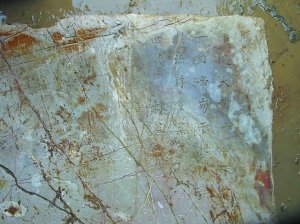Emperor's real burial site found in E China
 0 Comment(s)
0 Comment(s) Print
Print E-mail China Daily, April 16, 2013
E-mail China Daily, April 16, 2013
Although the tomb had been robbed, four valuable articles that could be used only by ancient royal family members were found, including lion-shaped door knockers made of gold and iron, and a jade belt decorated with gold.
 |
|
Stone tablet found in the tomb shows that Yang Guang, an emperor of the Sui Dynasty (AD 581-618), was buried there. |
However, according to the local archaeological bureau, no remains or coffin parts have been found yet.
The discovery of the tomb turned out to be a happy surprise for people living nearby.
"We heard that construction workers continuously found bricks in the site, which they thought were from normal ancient tombs," said Zhou Jian, a resident. "It never occurred to me that I'm the neighbor of an ancient emperor, even if he was a notorious one."
Archaeologists also discovered another tomb nearby, which they say might belong to Yang's queen.
The discovery proves that another mausoleum, which is about 6 kilometers from the construction site and has been thought to be Yang's burial site since the Qing Dynasty (1644-1911), is a fake, Shu said.
Compared with the tomb discovered, the "fake mausoleum" occupies an area of 30,000 sq m and has magnificent memorial arches, tomb doors and walls.






Go to Forum >>0 Comment(s)